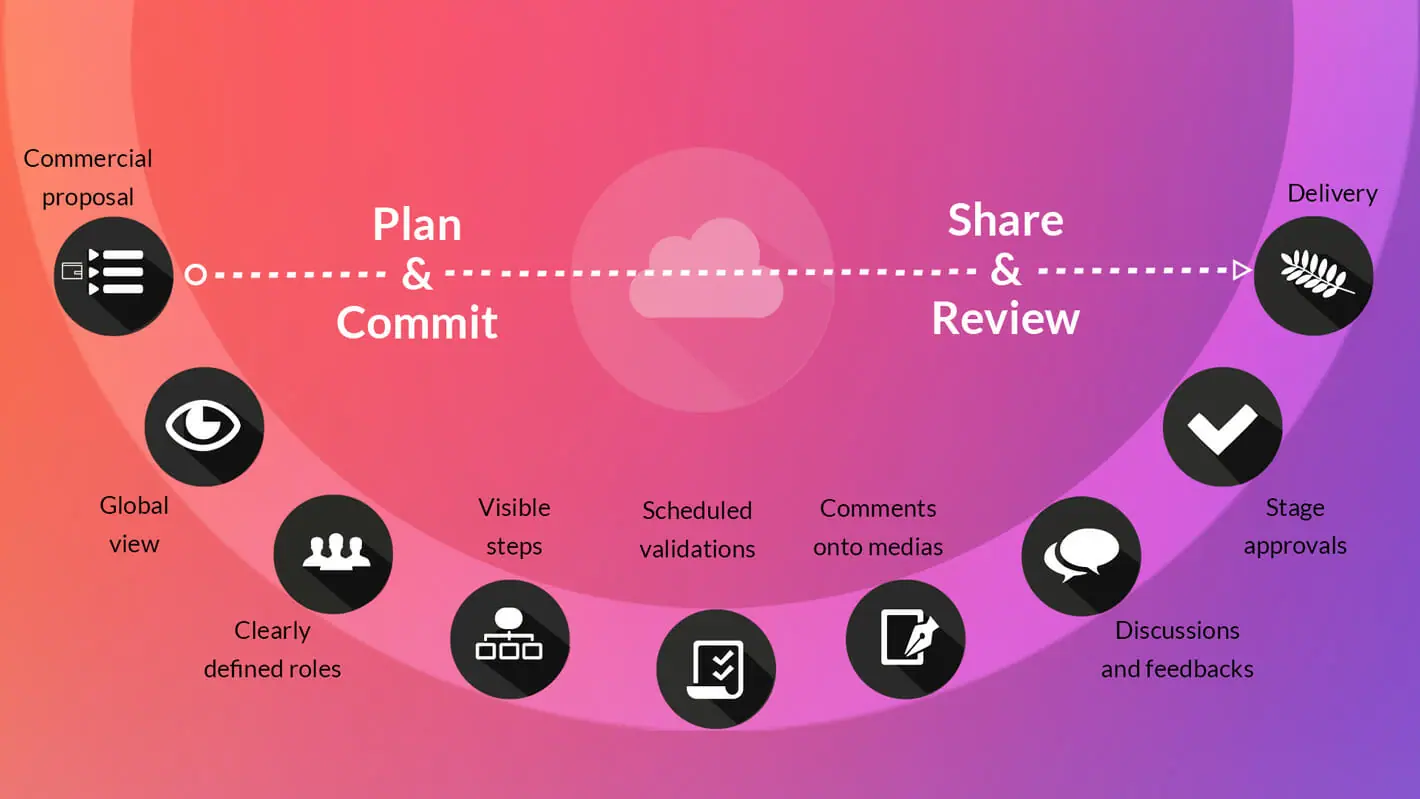Organizing video projects in a shared mode. Organizing and monitoring a project requires tools and methods. Here, everything is shared! Experiences, news, tips and articles to help you get the job done.
How to create an effective film production schedule?

Here are 4 key points for creating an effective film production schedule. A film production schedule is a fundamental part of audiovisual project organization. But let’s not reduce it to just a tool! It’s so much more than that: it reflects a strategy, reveals a working method and becomes a communication medium… The film production schedule must include the common basics of project management, but it must also and above all fit in with the philosophy of the production team and the customer context. How do you create a production schedule that effectively engages all players in the film’s success? Let’s go!
A film’s production schedule provides an overview
« What’s the next step? », « Can you tell us how it’s going? », « What’s the schedule? »… These questions from employees are recurrent as soon as the construction of a film goes beyond the « shot-on-set… »
Yes, there’s no doubt about it: making a film is neither a company’s core business, nor part of its daily routine. In fact, this is one of the raisons d’être of video agencies and production companies.
In some cases, responsibility for film production lies not with the company’s communications department, but with the business unit concerned with the film’s subject. The challenge is even greater for the production team, who will have to be more pedagogical, but also for the customer team, who will have to navigate in an ecosystem far removed from their daily lives. Video content producers have to be there, no matter what, to guide them along a more or less unknown path.
One of the first things an employee expects is a clear vision of the production stages. In fact, this is often one of the first questions asked when a project is launched.
So how do you provide the customer and creative teams with a vision?
Create a highly visual plan!
The kanban mode is nice for organizing personal tasks, but for providing a clear, global picture of the project, there are better ways. Use tools that enable you to create a highly visual schedule, such as a timeline, for an immediate understanding of busy periods, breaks, correction stages, etc. This will enable you to present a detailed roadmap, so that you can see what you’re doing and where you’re going. This will enable you to present a detailed roadmap and therefore a production schedule that provides all the necessary information. The result: an overall understanding of the process, from A to Z. Bingo.
Always create a film production schedule as if it were intended for a novice who knows nothing about the project. Ask yourself what questions they have, and answer them directly on the film production schedule. Bear in mind that if a production schedule is well drawn up, the number of questions in return should be close to zero…. It’s worth taking a little time to get started! And it increases your audience’s satisfaction.

Skeem.io schedule example
Add guidelines at every stage!
Yes, knowing the stages and their dates is a basic requirement, but it’s far from enough. Your contacts need to know the whys and wherefores of each stage. If they don’t, they’ll lose interest in the workflow, and won’t be committed when the time comes.
So use tools that allow you to add text, attachments or media at each stage of the production process to provide the following answers: « Here’s what this stage is about », « Here’s how we’re going to do it » and « Here’s what we expect from you at this point ».
A schedule is the basis for the personal organization of each project participant. It enables them to understand their role and better coordinate their work with other team members.

Production schedule defines clear roles
Creatives, clients: to each his role and to each his moment.
This is one of the foundations of orchestration. It’s one of the best practices to be tactfully communicated to all project participants. Everyone may have an advisory role, but we can all agree that collaboration is always a well-balanced mix of observation and proposal.
So, everyone has a role to play, and it’s only when a collaborator acts in his or her place that he or she proposes without creating friction.
In short, let’s not go on and on: clear assignments are sure to create fluidity (and no one complains).
« What do you want from us? », « What steps do we need to validate? » « Do you need any material that we can provide? », « Have you had a chance to give your feedback? »… If these questions arise during production, it’s because the planning can be improved!
So how do you define the roles in a video production schedule?
Identify and allocate key actions on the schedule
Use film production scheduling tools that enable controlled management of the schedule itself. This means knowing who is authorized to :
- Create and propose useful new production steps along the way,
- Modify existing stages and their content
- Modify dates and deadlines
Make sure that all actions are logged. This will avoid a few disappointments, or at least a few time-consuming, tense discussions.
Clearly assign key moments of interaction
These key moments structure collaboration, so it’s essential to identify them and clearly define who can or should :
- Exchange files, share resources
- Deliver different versions of videos or other media
- Provide feedback and annotate videos or other media
- Request validation
- Validate
- Deliver
By defining clear roles, the production schedule makes it easier to coordinate the activities of each collaborator, and reduces the risk of confusion or overlapping tasks. Each collaborator can concentrate on his or her own specific work, while knowing how he or she interacts with that of other project members.
Finally, the production schedule can help identify potential problems or delays that may arise, so that you can intervene upstream and modify the workflow.

Try out online schedule with Skeem! No credit card and no obligation!
A dynamic film production schedule
If anyone has ever experienced a film production without any changes to the schedule along the way, without any hazards likely to alter the initial sequence of production stages, let them speak or forever hold their peace. We’ll tell him it was a fluke.
Reality on the ground often means having to adapt to new constraints or take new elements into account (Didn’t I tell you?).
When it comes to efficiency and time-saving, it’s essential to integrate agile tools that not only enable rapid modification, but also instant sharing. The ideal solution, of course, is a collaborative one that allows you to keep track of everything in real time, turning a production schedule into a dynamic, effervescent communication tool at every stage of film production.
What better way to smooth customer relations?
A production schedule must be dynamic in the sense that it is able to adapt to the inevitable changes that may occur throughout the production process. It is important to understand that the initial planning is not necessarily definitive, and that it is often necessary to modify certain elements along the way.
Here are some of the advantages of dynamic production schedule:
Flexibility
A dynamic production schedule can be modified to adapt to unforeseen changes, such as delivery delays, technical problems or changes to the turning plan. This flexibility helps avoid production stoppages and delays.
Informed decision-making
By being able to modify the production schedule in real time, you can make more informed decisions based on the most recent information available. This can help avoid costly mistakes or unnecessary delays.
Resource optimization
A dynamic production schedule enables you to better manage available resources by allocating them to the tasks that need them most at any given time. This improves production efficiency.
Better communication
Agility enables you to be more present and discern the best time to communicate. A flexible schedule enables you to update information seamlessly and in real time. Anticipation avoids tension and considerably improves communication between clients and creatives, and between your team members.
In short, a dynamic film production schedule enables you to adapt to changes in real time and keep moving efficiently towards the final objective.
Collaborative schedule creation tools
Collaborative schedules are seen 20 times more than static ones
Obviously, at Skeem we love it and can’t recommend anything else!
A static schedule in Excel or equivalent is often never re-opened after the first consultation… So it’s (almost) useless. Not to mention the fact that you have to keep updating and sending back a new version, which usually loses everyone for good.
The arrival of collaborative platforms has revolutionized the way we engage our collaborators over time, using the video production schedule as a place for exchange and communication. We can quickly add to this the ease with which tools like Skeem allow you to edit a new schedule at the start of a project, and we’re usually won over… 😉
Creating an effective film production schedule is therefore central to the success of a film, because it will provide reassurance right from the start. The film production schedule is the reflection of know-how, and it’s this that gives confidence:
« They know where they’re going! Go ».
Let’s face it, it’s a good start!


